|
Where Do Atlantic Salmon Go to Beat the Heat?
New Calculator Helps Oyster Growers Measure the Water Quality Benefits of Farms
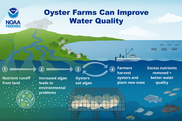
When it comes to removing excess nutrients from waterways, oysters and other shellfish are powerhouses. Our Milford Lab studies the ecosystem services—environmental benefits—shellfish provide, including nutrient removal. Nutrients like nitrogen are essential to life but when too much ends up in our coastal waters, algae and seaweed can grow out of control. This can cause problems like low dissolved oxygen and fish kills. Oysters help keep nutrients in the water in check by filter feeding on algae. By simply feeding, these mighty shellfish improve water quality. Our new Aquaculture Nutrient Removal Calculator lets oyster growers estimate how much nitrogen their oysters are removing from local waterways. It can also generate a report that growers can include in their aquaculture permit applications.
|
Once-in-a-Lifetime Find

Survey scientists unearthed something rather mysterious this summer during the 2024 Surfclam and Ocean Quahog Survey. It was some sort of odd-looking jawbone—a true head-scratcher. They connected with scientists at the Smithsonian’s National Museum of Natural History to find out what it might be. Turns out it’s likely a walrus jawbone from the Ice Age! We’re working to transfer the specimen to the Smithsonian in hopes they can learn more about the genealogy of walruses, and how walruses have changed over time.
|
Now Accepting IN FISH Applications for Summer 2025
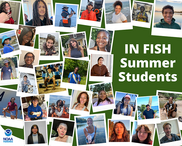
We are now accepting applications from undergraduates for our Inclusive NOAA Fisheries InternSHips (IN FISH). This program is a partnership among NOAA and our research partners in academia and non-governmental research institutions. It is a 10-week paid internship at a NOAA or partner institution marine research lab or marine resources program office. The experience includes a 2-week course available for credit through the University of Maryland Eastern Shore and 8 weeks of project experience working with a mentor in science or management.
|
Fisheries Monitoring and Research Division Celebrates Successful Reintegration of In-House Trainings
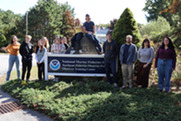
Over the past year, our Fisheries Monitoring and Research Division has worked hard to reintegrate two key fisheries observer trainings that were previously outsourced. The Fisheries Monitoring Operations Branch successfully transitioned all offshore marine safety trainings from an external contract to internal, staff-led trainings. In August, the branch held the first staff-led safety training in over a decade. In September, the Training and Data Quality Branch held its first at-sea monitor training in more than two years. These challenging transitions were met with great success, reflecting the hard work, dedication and expertise of the division.
|
New Additions to the Aquarium Gallery in the Spirit of Halloween
To celebrate Halloween, we are sharing spooky x-rays of some of our favorite Woods Hole Science Aquarium residents. Stumpy is our diamondback terrapin. It's estimated that Stumpy was hatched in 2006. We’ve had him at our aquarium since 2008. He likes to eat herring and capelin and krill, but his favorite food is shrimp. Our Woods Hole Science Aquarium was established in 1875, making it the country's oldest public aquarium. Visitors can see about 90 species of marine and estuarine animals found in Northeast and Mid-Atlantic U.S. waters. We are open to the public Monday through Friday, 11:00 a.m. to 4:00 p.m., and closed weekends and federal holidays.
|
New Photos from Our 2024 Ecosystems Monitoring Survey
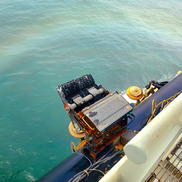
Our Ecosystem Monitoring Survey helps researchers understand and predict changes in the Northeast shelf ecosystem and its fisheries. Core sampling provides data that help us understand ocean acidification and changes in water temperature, salinity, the distribution and abundance of zooplankton and larval fish, and more. Check out the latest photos from our fall Ecosystem Monitoring Survey!
|
Blog: There’s a First Time for Everything
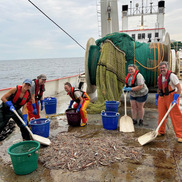
Join fisheries biologist Mary Kate Munley on our first cruise in a quest to learn how ocean conditions affect shortfin squid. She was onboard the F/V Dyrsten for a 3-day research trip last June to investigate how oceanography affects shortfin squid movement and biology in the Mid-Atlantic Bight. During the cruise, the team characterized the oceanography at 14 locations and caught approximately 25,000 pounds of shortfin squid. This work is just one component of our center’s cooperative effort with industry to better understand our squid stocks. By pairing oceanographic data with abundance and biomass estimates, we hope to provide insight into squid biology and movement.
|
Blog: Observing—Six Things I’ve Learned in a Year
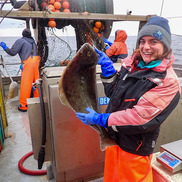
Working as a fisheries observer, you learn a thing or two over the course of a year. Observer Leah Jones shares her top six in her new blog. She explains how she learned to identify sharks, managed seasickness, and kept warm at sea, among other valuable lessons. Leah is an observer in the Northeast Fisheries Observer and At-Sea Monitor Programs. She has spent over 100 days at sea collecting biological data aboard commercial fishing vessels in the Mid-Atlantic and New England, mostly deploying out of ports in New York.
|
Director's Message
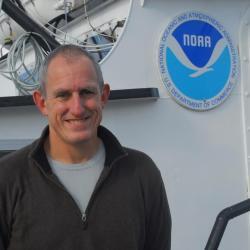
What does a scientific administrator do on a 9 hour drive to a fisheries management council meeting? Binge listen to the Dive in with NOAA Fisheries podcast with John Sheehan, of course! John’s podcast covers a range of topics including:
These stories also emphasize the interconnectedness of our work: the complexity of ecosystems and the important part that we humans play. Next time you have 20 minutes—or 9 hours—I encourage you to Dive in with NOAA Fisheries.
|
|
|
Upcoming Meetings and Events
Nov 4: Winter flounder working group meeting
Nov 13-14: Flatfish Biology Conference
Nov 18-21: Yellowtail flounder research track peer review meeting
Nov 21: Longfin squid working group meeting
|
|
Upcoming Deadlines
Nov 4: Grant proposals due: Citizen Science for Improved Stock Assessments and Climate-Ready Fisheries Management
Nov 8: Last day to register for 2025 Cooperative Research Summit (join the waitlist)
Nov 11: Abstract submission deadline for Milford Aquaculture Seminar
Nov 22: Abstract submission deadline for 2025 Cooperative Research Summit
|
|
|
|